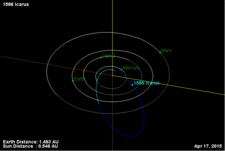1566 Icarus
 |
|
| Discovery | |
|---|---|
| Discovered by |
Walter Baade Palomar Observatory |
| Discovery date | 27 June 1949 |
| Designations | |
|
Named after
|
Icarus |
| 1949 MA | |
|
Apollo asteroid, PHA Mercury-crosser asteroid, Venus-crosser asteroid, Mars-crosser asteroid |
|
| Orbital characteristics | |
| Epoch 31 July 2016 (JD 2457600.5) | |
| Uncertainty parameter 0 | |
| Observation arc | 65.98 yr (24099 days) |
| Aphelion | 1.96951 AU (294.635 Gm) |
| Perihelion | 0.18664 AU (27.921 Gm) |
| 1.07808 AU (161.278 Gm) | |
| Eccentricity | 0.82687 |
| 1.12 yr (408.86 d) | |
| 39.421576° | |
| 0° 52m 49.796s / day | |
| Inclination | 22.82686° |
| 88.01237° | |
| 31.38170° | |
| Earth MOID | 0.0343735 AU (5.14220 Gm) |
| Jupiter MOID | 3.22158 AU (481.942 Gm) |
| Jupiter Tisserand parameter | 5.298 |
| Physical characteristics | |
| Dimensions | 1.27 km |
|
Mean radius
|
0.5 km |
| Mass | 2.9×1012 kg |
|
Mean density
|
2 ? g/cm³ |
|
Equatorial surface gravity
|
0.000 39 m/s² |
|
Equatorial escape velocity
|
0.000 74 km/s |
| 2.2726 h (0.09469 d) (0.094 71 d) |
|
| 0.4, 0.51 | |
| Temperature | ~242 K |
| S/Q | |
| 16.9 | |
1566 Icarus (/ˈɪkərəs/ IK-ə-rəs) is an Apollo asteroid (a subclass of near-Earth asteroid) that at perihelion comes closer to the Sun than Mercury, i.e. it is a Mercury-crossing asteroid. It is also a Venus and Mars-crosser. It is named after Icarus of Greek mythology, who flew too close to the Sun. It was discovered on 27 June 1949 by Walter Baade at Palomar Observatory. From 1949 until the discovery of 3200 Phaethon in 1983, it was known as the asteroid that passed closest to the Sun.
Icarus is the lowest numbered potentially hazardous asteroid (PHA). Icarus makes close approaches to Earth in June at intervals of 9, 19, or 28 years. Rarely, it comes as close as 0.042482 AU (6,355,200 km; 3,948,900 mi) (16 lunar distances), as it did on 14 June 1968. During this approach, Icarus became the first minor planet to be observed using radar, with measurements obtained at the Haystack Observatory and the Goldstone Tracking Station. As of 2015, the last close approach was on 16 June 2015, at 0.05383 AU (8,053,000 km; 5,004,000 mi). Before that, the previous close approach was on 11 June 1996, at 0.10119 AU (15,138,000 km; 9,406,000 mi), almost 40 times as far as the Moon. The next notably close approach will be on 13 June 2043, at 0.0586 AU (8,770,000 km; 5,450,000 mi) from Earth.
...
Wikipedia
